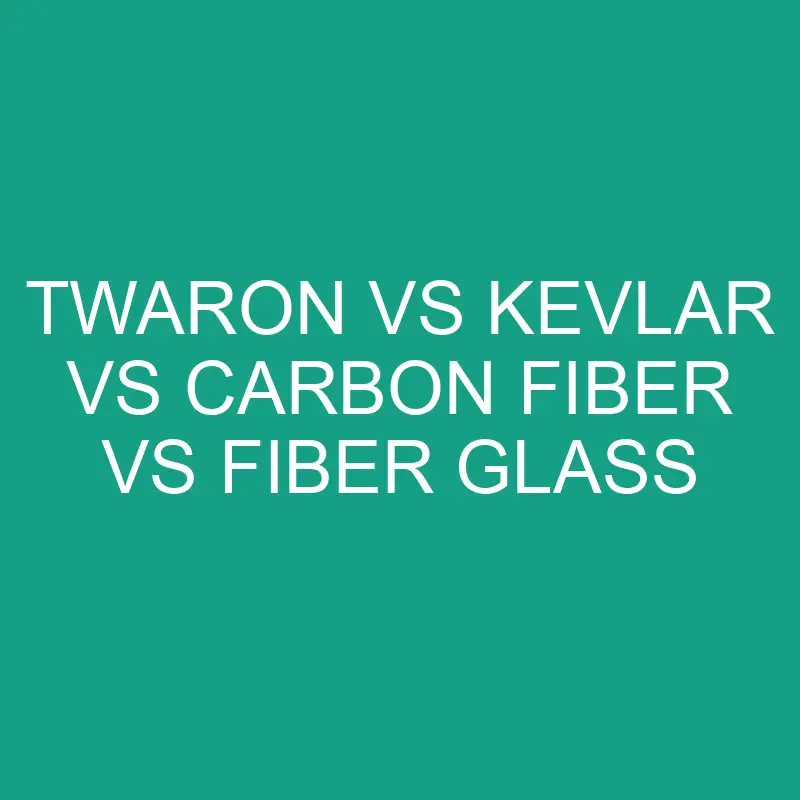Twaron, Kevlar, Carbon Fiber, and Fiber Glass are all materials that are commonly used in various industries. While they may sound similar, they each have their own distinct characteristics and purposes. In this article, we will define each of these materials and highlight their similarities and differences.
Twaron
Twaron is a high-strength, heat-resistant synthetic fiber developed by Teijin Aramid. It is made from para-aramid fibers and is known for its excellent strength, stiffness, and thermal stability. Twaron is used in a variety of applications, including body armor, protective clothing, and sporting goods.
Example: Bulletproof vests are often made from Twaron fibers, which provide excellent protection against ballistic threats.
Pros:
- High strength and stiffness
- Excellent thermal stability
- Resistant to abrasion and chemicals
Cons:
- Expensive compared to other fibers
- Limited availability
Kevlar
Kevlar is a high-strength synthetic fiber developed by DuPont. It is made from para-aramid fibers and is known for its excellent strength, stiffness, and durability. Kevlar is used in a variety of applications, including body armor, protective clothing, and aerospace components.
Example: Kevlar is commonly used in body armor, providing protection against ballistic threats.
Pros:
- High strength and stiffness
- Excellent durability
- Resistant to heat and abrasion
Cons:
- Expensive compared to other fibers
- Limited availability
Carbon Fiber
Carbon fiber is a lightweight, high-strength material made from carbon fibers that have been woven together into a fabric. Carbon fiber is known for its excellent strength, stiffness, and low weight. It is used in a variety of applications, including aerospace components, sports equipment, and high-performance automobiles.
Example: Carbon fiber is commonly used in aerospace components, such as the wings of airplanes, because of its high strength and low weight.
Pros:
- High strength and stiffness
- Low weight
- Resistant to corrosion
Cons:
- Expensive compared to other materials
- Brittle and prone to cracking
Fiber Glass
Fiber glass is a composite material made from glass fibers that have been woven together into a fabric. It is known for its excellent strength, stiffness, and durability. Fiber glass is used in a variety of applications, including construction, automotive components, and watercraft.
Example: Fiber glass is commonly used in boat hulls because of its excellent durability and resistance to water.
Pros:
- High strength and stiffness
- Durable and resistant to water
- Inexpensive compared to other materials
Cons:
- Heavy compared to other materials
- Prone to cracking and damage over time
Comparison Table:
| Feature | Twaron | Kevlar | Carbon Fiber | Fiber Glass |
|---|---|---|---|---|
| Composition | Para-aramid fibers | Para-aramid fibers | Carbon fibers | Glass fibers |
| Strength | High | High | High | High |
| Stiffness | High | High | High | High |
| Weight | Medium | Medium | Low | High |
| Thermal stability | Excellent | Excellent | Good | Poor |
| Durability | Good | Excellent | Good | Excellent |
| Corrosion resistance | Good | Good | Excellent | Good |
| Cost | Expensive | Expensive | Expensive | Inexpensive |
Conclusion
In summary, Twaron, Kevlar, Carbon Fiber, and Fiber Glass are all materials with unique characteristics that make them suitable for various applications. Twaron and Kevlar are both high-strength, heat-resistant synthetic fibers used in body armor and protective clothing. Carbon fiber is a lightweight, high-strength material used in aerospace components
